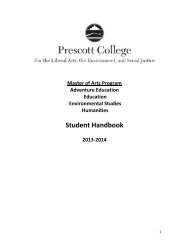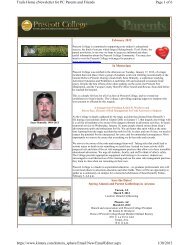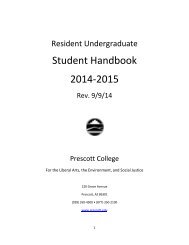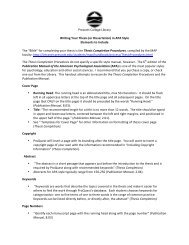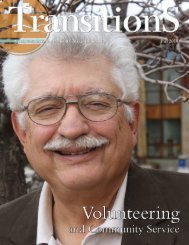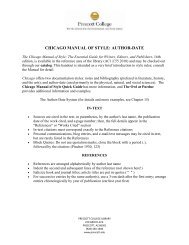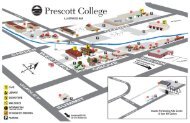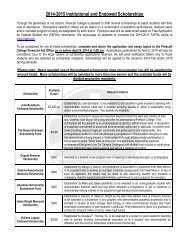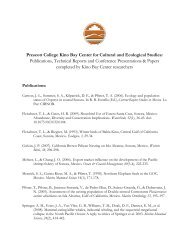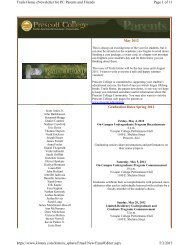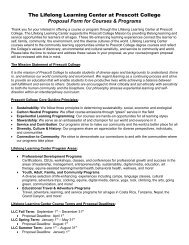Transitions Magazine Spring 2013 - Prescott College
Transitions Magazine Spring 2013 - Prescott College
Transitions Magazine Spring 2013 - Prescott College
- No tags were found...
You also want an ePaper? Increase the reach of your titles
YUMPU automatically turns print PDFs into web optimized ePapers that Google loves.
history. Poets and painters, biologists and psychologists, teachersand land managers engaged in animated discussion—on everythingfrom the relationship of emotional and rational ways of interactingwith the world, to technical research issues, to natural history in thedigital age. A social movement had erupted. At one of the sessions,nine of the 25 participants were affiliated with <strong>Prescott</strong> <strong>College</strong>.These sessions and the follow-up symposium at another ESAconference affirmed the notion that we are really doing somethingright here (the organization now has a formal Natural HistorySection)—and that <strong>Prescott</strong><strong>College</strong> is at the center ofthis important movement.In the spring of 2011,seven <strong>Prescott</strong> <strong>College</strong>students and I joined withpeers from our sister school,<strong>College</strong> of the Atlantic,to present “Teaching andLearning Natural History inthe Field,” a special sessionat the Society for HumanEcology conference. Oneof the conference’s keynotespeakers commented that thestudent presentations wereamong the most hopefulthings she’d witnessed in avery long time. Meanwhile,a multi-media exhibit, “TheNatural Histories Project”(naturalhistoriesproject.org),Masked Trogon, Ecuadorwhich grew out of recorded conversations duringthe From Decline to Rebirth sessions, was featuredat a second ESA conference, and is currently beingdeveloped into a traveling exhibition.It only seemed natural that the institution centralto the practice and renaissance of natural history inhigher education establish a center of excellence toserve as a local and national resource on the subject.This past summer, after two years of planning, the<strong>College</strong> founded the Natural History Institute. I have the honor ofserving as its first director. The Institute’s mission is to provide“leadership and resources for a revitalized practice of natural history,integrating sciences, arts, and humanities, within <strong>Prescott</strong> <strong>College</strong>and throughout North America.” This will be accomplished bycreating a natural history lab for <strong>Prescott</strong> <strong>College</strong> classes from acrossthe curriculum; providing space and resources for student andfaculty research; offering public programs, including exhibitions,lectures, and field experiences; by archiving and documentinglandscape change in the bi-national Southwest (slide collections,significant field notes, etc.); and by archiving digital and physicalcollections of biological and cultural resources of the ArizonaCentral Highlands and adjacent ecoregions.A singular feature of the <strong>Prescott</strong> <strong>College</strong> Natural HistoryInstitute is explicit integration of art, science, and humanities—atrue liberal arts approach to natural history, harkening back to theinterdisciplinary roots and history of the field. Rather than aimingat a narrow or superficial subset of biological science, the Institutewill demonstrate that natural history is larger than science alone.Original Audubon prints will hang next to Seri baskets, in a roomwhere literary naturalists give readings, around the corner fromscientific collections of biological diversity.It is remarkable what <strong>Prescott</strong> <strong>College</strong> has accomplished in therealm of natural history in spite of a distinct dearth of physical resources.The new Institute, infused with the thrust of the Arader artcollection, will propel the <strong>College</strong> into an extraordinary new phaseof leadership in natural history education, research,and outreach.Tom Fleischner (left), Director of the Natural History Institute,has taught natural history and conservation biologyat <strong>Prescott</strong> <strong>College</strong> for 25 years; he is also the foundingPresident of the Natural History Network (naturalhistorynetwork.org).If you are interested in learning moreabout the Natural History Institute or if you would liketo make a donation to support its programming, visithttp://www.naturalhistoryinstitute.org or https://www.facebook.com/NaturalHistoryInstitute?fref=ts for infoand http://naturalhistory.kintera.org to donate, or contactTom at naturalhistory@prescott.edu.INTEGRATING ART, SCIENCE, AND HUMANITIESLizard on Slickrock, PariaCanyon, The Colorado Plateau:Natural History andConservation, 1990Exploring tidepools, Kino Bay, Coastal Ecology of the Gulf of California, 19928<strong>Transitions</strong> <strong>Spring</strong> <strong>2013</strong>



